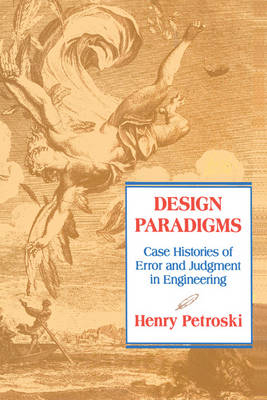
Design Paradigms
Cambridge University Press (Verlag)
978-0-521-46649-3 (ISBN)
From ancient Greek temples to twentieth-century towers, engineers have learned more about design from failure than success. The concept of error, according to the author, is central to the design process. As a way of explaining the enduring aspects of engineering design, he relates stories of some of the greatest engineering successes and failures of all time. These case studies, drawn from a wide range of times and places, serve as paradigms of error and judgment in engineering design. By showing how errors were introduced in the design process and how they might be avoided, the book suggests how better quality and reliability might be achieved in designed devices, structures, and systems of all kinds. Clearly written, with striking illustrations, the book will appeal to engineering students, practising engineers, historians of science and technology, and all those interested in learning about the process of design.
1. Introduction; 2. Paconius and the pedestal for Apollo: a paradigm of error in conceptual design; 3. Vitruvius's Auger and Galileo's Bones: paradigms of limits to size in design; 4. Galileo and the marble column: a paradigm of a design change for the worse; 5. Galileo's confirmation of a false hypothesis: A paradigm of logical error in design; 6. The design and collapse of the Dee Bridge: a paradigm of success masking error; 7. The Britannia Tubular Bridge: A paradigm of tunnel vision in design; 8. Failure as a source of engineering judgment: John Roebling as a paradigmatic designer; 9. The design climate for the Tacoma Narrows Bridge: a paradigm of the selective use of history; 10. Historic bridge failures and caveats for future designs; 11. Conclusion; References and bibliography; Index.
| Erscheint lt. Verlag | 27.5.1994 |
|---|---|
| Zusatzinfo | Worked examples or Exercises |
| Verlagsort | Cambridge |
| Sprache | englisch |
| Maße | 152 x 227 mm |
| Gewicht | 342 g |
| Themenwelt | Kunst / Musik / Theater ► Design / Innenarchitektur / Mode |
| Kunst / Musik / Theater ► Kunstgeschichte / Kunststile | |
| Geschichte ► Teilgebiete der Geschichte ► Technikgeschichte | |
| Technik | |
| ISBN-10 | 0-521-46649-0 / 0521466490 |
| ISBN-13 | 978-0-521-46649-3 / 9780521466493 |
| Zustand | Neuware |
| Haben Sie eine Frage zum Produkt? |
aus dem Bereich


